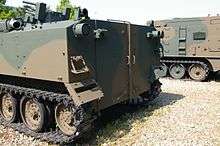Type 73 Armored Personnel Carrier
| Type 73 Armored Personnel Carrier | |
|---|---|
|
A Type 73 of the JGSDF displayed at Camp Jinmachi | |
| Type | Armored personnel carrier |
| Place of origin | Japan |
| Service history | |
| In service | 1973 – Present |
| Used by |
|
| Production history | |
| Designer | Mitsubishi Heavy Industries |
| Designed | 1967–1972 |
| Manufacturer | Mitsubishi Heavy Industries |
| Unit cost | $4.1 million |
| Produced | 1973–? |
| Number built | 338 (2012) |
| Specifications | |
| Weight | 13.3 tonnes (14.7 short tons) |
| Length | 5.8 metres (19 ft) |
| Width | 2.8 metres (9.2 ft) |
| Height | 2.2 metres (7.2 ft) |
| Crew | 3 + 9 |
|
| |
Main armament | 1x 12.7 mm M-2HB machine gun |
Secondary armament | 1x 7.62 mm M-1919A4 bow machine gun |
| Engine |
Mitsubishi 4ZF air-cooled V-type 4-cylinder diesel 300 horsepower (300 PS) |
| Suspension | torsion bar |
| Ground clearance | 40 centimetres (16 in) |
| Fuel capacity | 450 litres (120 US gal) |
Operational range | 300 kilometres (190 mi) |
| Speed | 70 kilometres per hour (43 mph) (road) |
The Type 73 Armored Personnel Carrier (73式装甲車 nana-san-shiki-soukou-sya) is an armored personnel carrier that entered service with Japan Ground Self-Defense Force in 1973.
Development
The Japanese Defense Agency's Technical Research and Development Institution issued a requirement for a new APC to replace the Type 60 APC in 1967.[1] Among the requirements included a maximum speed of over 60 km/h, ability to carry 12 men including the crew, to be fully amphibious, have all-welded aluminium armor, provision for the infantry to use their small arms from inside the vehicle and be armed with a 20 mm cannon, a 12.7 mm machine gun and a 7.62 mm machine gun.[1] An automotive test rig, called the SUT, was built in 1968. Komatsu and Mitsubishi Heavy Industries each built two prototypes the following year, one each in steel and aluminium. Mitsubishi's aluminium model was chosen for use in December 1973.[1]
Description
The Type 73 is almost unique in that it uses a mid-engined V4 layout, as the driver and bow machine gunner are in the front of the vehicle. The commander sits slightly behind the bow gunner while the gunner sits behind the driver. The engine is mounted on the left side behind the bow gunner with both its air intake and exhaust on the top of the vehicle. The engine and transmission are designed to be easily removed as one complete unit. The gunner's cupola can traverse a full 360°, but the bow gunner's weapon can only traverse, elevate and depress 30°. It is fitted with six smoke dischargers, three on each side. Its infantry can fire their personal weapons from inside the vehicle. The Type 73 requires additional equipment to become amphibious and is propelled through the water by its tracks at a maximum speed of 7 kilometres per hour (4.3 mph). It is fitted with infra-red driving lights and an NBC system.

Variants
A command version is in service with a raised roof. The Type 73's chassis served has been adapted for use by the Type 75 130 mm Multiple Rocket Launcher, its companion Type 75 wind measurement vehicle and the Type 74 105 mm Self-propelled howitzer.
Status
As of 2001, Japan reported to the United Nations Office for Disarmament Affairs that 337 Type 73s were in service,[2] although it seems unlikely to be fully superseded due to the Type 89's slow production rate.
Notes
- 1 2 3 "Mitsubishi Type 73 armoured personnel carrier (Japan), Armoured personnel carriers (tracked)". Jane's. Archived from the original on 9 June 2011. Retrieved 2011-06-08.
- ↑ "JGSDF Inventory circa 2001". United Nations. Retrieved 24 December 2008.
References
- Chant, Christopher. A Compendium of Armaments and Military Hardware. New York and London: Routledge & Kegan Paul, 1987 ISBN 0-7102-0720-4, p. 51-2
| Wikimedia Commons has media related to JGSDF Type 73 (APC). |
External links
- Type 73 on military-today.com
- Type 73 on deagel.com
- Type 73 on OnWar.com
- excerpt from Jane's Armour and Artillery 2008
